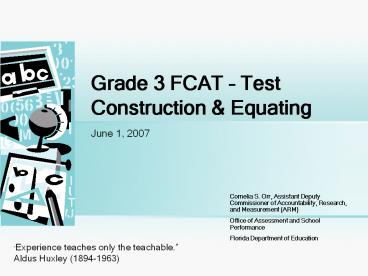Grade 3 FCAT - PowerPoint PPT Presentation
1 / 18
Title:
Grade 3 FCAT
Description:
Florida Department of Education. 2. Topics. The Grade 3 Test in ... Review of Content DOE Content Staff. Review of Statistics Harcourt Psychometric Staff ... – PowerPoint PPT presentation
Number of Views:39
Avg rating:3.0/5.0
Title: Grade 3 FCAT
1
Grade 3 FCAT Test Construction EquatingJune
1, 2007
- Cornelia S. Orr, Assistant Deputy Commissioner of
Accountability, Research, and Measurement (ARM) - Office of Assessment and School Performance
- Florida Department of Education
Experience teaches only the teachable. Aldus
Huxley (1894-1963)
2
Topics
- The Grade 3 Test in 2006
- Test Construction
- Process and Product
- Science and Art
- Psychometric Primer
- Test Calibration and Equating
3
The Grade 3 Test in 2006
- Passages Questions Forms
- Student scores based on 5 passages 45 questions
- 30 different forms, each with 1 passage 7-8
questions - Forms are used for anchor and field test
questions - One of the 6 passage positions is used for anchor
and field test questions
2006 Grade 3 FCAT Test Passages and Positions 2006 Grade 3 FCAT Test Passages and Positions 2006 Grade 3 FCAT Test Passages and Positions 2006 Grade 3 FCAT Test Passages and Positions 2006 Grade 3 FCAT Test Passages and Positions 2006 Grade 3 FCAT Test Passages and Positions 2006 Grade 3 FCAT Test Passages and Positions
Day 1 Session 1 Day 1 Session 1 Day 1 Session 1 Day 2 Session 2 Day 2 Session 2 Day 2 Session 2
1 2 3 4 5 6
4
The Grade 3 Test in 2006
2006 Grade 3 FCAT Test Passages and Positions 2006 Grade 3 FCAT Test Passages and Positions 2006 Grade 3 FCAT Test Passages and Positions 2006 Grade 3 FCAT Test Passages and Positions
Day/ Session Passage Position Number of Questions Passage Description
1 1 8 Ladybird, Ladybird, Fly Away Home (Lit.)
1 2 7 or 8 Anchor and Field Test Passages (Varies)
1 3 10 A Gift of Trees (Inform.)
2 4 13 Swim, Baby, Swim (Lit.)
2 5 8 Slip, Slop, Slap/Sunny Sidebar (Inform.)
2 6 6 Making Spring (Lit.)
TOTAL 52-53
5
Test Construction
- Process of building the test
- Occurs the summer before a test
- Based on available passages, questions, and
statistics - Guidelines for building the test
- Test Construction Specifications
- Building the test is an iterative process
6
(No Transcript)
7
Test Construction Specifications - 1
- Guidelines for building the test
- Ranges for each category
- Iterative process
- Content Guidelines
- Reading Passages (type and word counts)
- Benchmark Coverage
- Reporting Category (Strand) Coverage
- Multicultural Gender Representation
- Cognitive Level Guidelines
8
Test Construction Specifications 2
- Statistical Guidelines for Questions
- Classical Item Difficulty and Discrimination
- IRT Difficulty, Discrimination, and Guessing
- Differential Item Functioning (DIF)
- IRT Model Fit Statistics
- Statistical Guidelines for Tests
- Test Characteristic Curves
- Test Information Functions
- Standard Error Curves
9
Test Construction Specifications 3
- Anchor Item Guidelines
- Number and position of questions
- Content Representation Mini Test
- Performance Characteristics (range of difficulty)
- Previous use as a Core or Anchor
- No change in wording
- Passage position
10
Test Construction Review and Approval Process
- 1st Draft of Content Harcourt Content Staff
- Review of Content DOE Content Staff
- Review of Statistics Harcourt Psychometric
Staff - Review of Statistics DOE Psychometric Staff
- Approval by DOE FCAT team leadership
11
Psychometric Primer -1
- Classical Item Statistics
- P-value or difficulty the percent (P) who
answer the question correctly. - Discrimination (point-biserial) the degree to
which students who get high scores answer the
question correctly and vice versa (similar to
correlation).
12
Psychometric Primer -2
- Item Response Theory (IRT) Statistics
- A-parameter discrimination or how well the
question differentiates between lower and higher
performing students. - B-parameter difficulty or the level of ability
on the 100-500 scale required to answer the
question correctly. - Guessing the probability of examinees with
extremely low ability levels getting a correct
answer. - FIT how well the scores for a given item fit,
or match, the expected distribution for the
model. - DIF (Differential Item Functioning) the degree
to which the question performs similarly for all
demographic groups based on ability.
13
Item Characteristic Curve Figure 1
14
Test Characteristic Curve Figure 2
15
Standard Error Curve Figure 3
16
Test Calibration and Equating
- Calibration Converting from Raw Scores to IRT
scores - Equating Making Scores Comparable Across Years
- Florida uses Item Response Theory (IRT) to score
and equate FCAT results from year to year.
17
(No Transcript)
18
Equating Solutions
- 2006 equating solution anchor questions ???
- Identify a better equating solution
- Define better
- Process considerations
- Select anchor questions
- Follow the guidelines
- Evaluate the quality of the anchor































